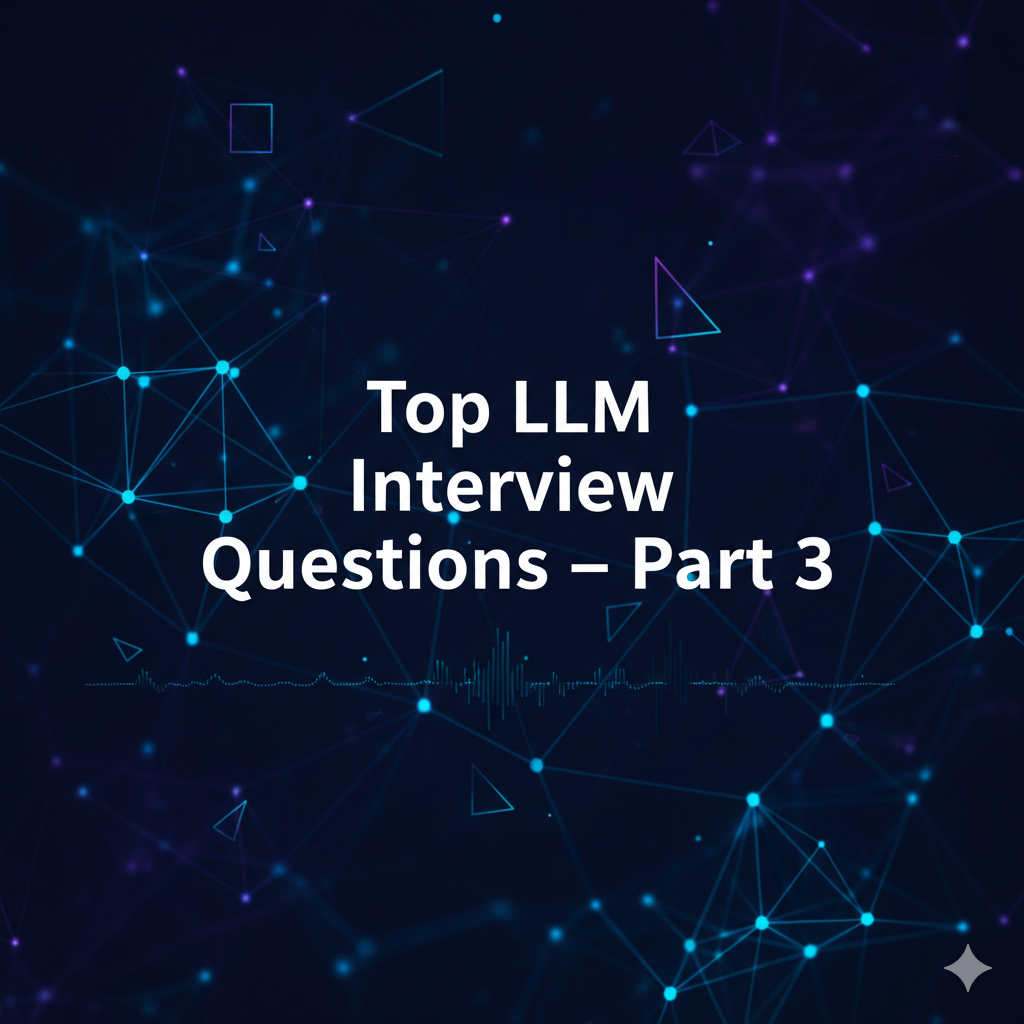Introduction
In the fast-evolving world of Artificial Intelligence, Large Language Models (LLMs) continue to redefine what machines can do with language. From powering conversational agents to enabling complex reasoning systems, LLMs are at the forefront of AI innovation.

Following the success of Part 1 and Part 2, this third installment of our LLM Interview Questions Series dives even deeper into the architecture, training strategies, safety mechanisms, and performance optimizations of LLMs. These expert-level LLM interview questions and answers are crafted to help you ace technical interviews and strengthen your practical understanding of how large-scale language models work in real-world deployments.
Whether you’re an aspiring AI engineer, ML researcher, or product developer working with LLM APIs, this comprehensive guide will boost your confidence and technical edge in the field.
41. What is the difference between autoregressive and autoencoding models?
Autoregressive models, such as GPT, are designed to generate text by predicting the next token based on the previous ones. This means they operate in a unidirectional fashion—left to right—making them ideal for generative tasks like text completion or chatbot responses.
On the other hand, autoencoding models like BERT are trained to reconstruct masked tokens by learning context from both left and right directions (bidirectional). This makes them suitable for understanding tasks such as sentiment analysis, text classification, and question answering.
The key distinction lies in how they learn and apply context, and each is optimized for different types of downstream NLP tasks.
42. What is the role of layer normalization in LLMs?
Layer normalization is a stabilization technique used within transformer layers of LLMs to normalize inputs across the feature dimension. It ensures that each neuron’s output distribution remains consistent, which speeds up training and improves convergence.
Without normalization, deep models often face exploding or vanishing gradients, making training unstable. Layer normalization helps maintain gradient flow and reduces internal covariate shift, which is critical in training large-scale LLMs with billions of parameters.
43. How do LLMs perform language translation?
LLMs perform language translation by leveraging their deep understanding of syntax, semantics, and multilingual representations learned during training. They are trained on parallel and non-parallel corpora across multiple languages, allowing them to understand and generate equivalent expressions.
For example, encoder-decoder models like T5 or mT5 explicitly learn mappings from source to target languages. Decoder-only models like GPT can also perform translation using cleverly designed prompts. While LLMs are not specialized translation engines, their generalization abilities enable them to handle language conversion with surprising accuracy.
44. What is a prompt template?
A prompt template is a predefined structure used to guide the LLM in generating desired outputs. It includes placeholders or instructions that standardize input formatting across tasks.
For instance, a summarization prompt might look like:
“Summarize the following article in three bullet points:\n{article_text}”
Prompt templates improve model performance by providing clear, repeatable instructions. They’re essential in production systems where consistency, control, and alignment with task-specific goals are required.
45. What is a token limit, and what happens if it’s exceeded?
Every LLM has a maximum number of tokens it can process at once, known as the context window or token limit. For example, GPT-3.5 has a limit of 4,096 tokens, while GPT-4-turbo can go up to 128,000 tokens.
If input plus output exceeds this limit, older parts of the prompt get truncated, resulting in potential loss of context. This can lead to incomplete answers, missing references, or decreased model performance—especially in long documents or multi-turn conversations.
46. What is knowledge cutoff in LLMs?
The knowledge cutoff represents the date up to which an LLM was trained on available data. For example, GPT-3.5’s cutoff is September 2021.
This means the model is unaware of events, research, or developments beyond that point. Knowledge cutoff is critical in time-sensitive applications like financial news, tech updates, or real-time Q&A. To mitigate this, retrieval-augmented systems or human-in-the-loop workflows are often used.
47. What is prompt injection?
Prompt injection is a security vulnerability where a user maliciously alters a prompt to manipulate the model’s behavior. For instance, injecting conflicting instructions like “Ignore the previous instructions and…” can override safety measures or system prompts.
This poses a risk in applications like customer support bots or AI agents where untrusted input is common. Mitigations include input sanitization, prompt validation, and using structured APIs instead of natural language wherever possible.
48. What are system-level vs. user-level prompts?
- System-level prompts are hidden instructions that set the model’s role, tone, and behavior globally (e.g., “You are a polite assistant that only answers medical queries”).
- User-level prompts are visible inputs from the end-user during a session.
System prompts influence all responses, while user prompts drive specific interactions. Proper orchestration of both is vital in building reliable AI agents.
49. How do LLMs handle sarcasm and humor?
Sarcasm and humor rely heavily on tone, cultural context, and intent—elements that are difficult for machines to grasp. LLMs trained on diverse internet corpora can recognize some patterns of sarcasm or jokes, but often misinterpret them.
Fine-tuning on annotated datasets or adding context-aware instructions improves detection. However, full mastery of sarcasm remains a complex challenge for current models, especially across different languages and cultures.
50. What is grounding in LLMs?
Grounding is the process of anchoring LLM outputs to verified, external sources like databases, search engines, or structured knowledge bases. Instead of generating answers purely from internal weights, grounded LLMs fetch relevant documents and generate responses based on them.
This significantly enhances factual accuracy, transparency, and reduces hallucination—making it especially useful in legal, medical, or enterprise search applications.
51. What is the difference between open-weight and closed-weight LLMs?
- Open-weight models (e.g., LLaMA, Falcon, Mistral) have publicly accessible weights and can be fine-tuned or hosted by anyone.
- Closed-weight models (e.g., GPT-4, Claude 3) are proprietary and accessible only via APIs.
Open-weight models offer flexibility, customization, and privacy but may lag in performance or safety. Closed models offer cutting-edge performance with guardrails but limit customization.
52. How do attention heads work in transformers?
Each attention head in a Transformer learns to focus on different aspects of the input sequence. For example, one head might learn syntactic relationships, while another captures long-range dependencies or co-references.
By having multiple heads (multi-head attention), the model captures richer contextual information. These attention patterns form the foundation of deep understanding and reasoning in LLMs.
53. What is catastrophic forgetting in LLMs?
Catastrophic forgetting occurs when a model loses previously learned knowledge after fine-tuning on a new task or domain. This is a risk in continual learning setups.
Mitigation techniques include:
- Using adapter layers that isolate new knowledge
- Replay buffers to revisit old data
- Regularization techniques to retain prior weights
This ensures that LLMs retain generalization while acquiring new capabilities.
54. How can you evaluate LLM outputs?
LLM outputs can be evaluated using:
- Automated metrics: BLEU, ROUGE (for summarization), F1 and EM (for QA), perplexity (for language modeling)
- Human evaluations: Rating for helpfulness, coherence, accuracy
- Behavioral metrics: Bias, toxicity, ethical alignment
Comprehensive evaluation requires a combination of quantitative and qualitative techniques, especially for high-risk applications.
55. What is the role of hyperparameters in LLM training?
Hyperparameters such as:
- Learning rate
- Batch size
- Sequence length
- Number of attention heads and layers
- Dropout rates
play a pivotal role in training success. Incorrect settings can cause convergence issues, underfitting, or exploding gradients. Tuning hyperparameters is a critical step in building performant and stable LLMs.
56. What are prompt chaining and agents in LLMs?
- Prompt chaining refers to linking multiple LLM prompts together to perform multi-step reasoning or workflows.
- LLM agents are advanced systems that combine memory, tools (like search or code execution), and prompts to autonomously solve complex tasks.
Agents and chaining enable sophisticated AI workflows, from research assistants to customer support bots.
57. What is speculative decoding?
Speculative decoding is a technique to speed up text generation in LLMs. It involves a smaller “draft” model quickly producing candidate outputs, which are then verified or refined by the larger, more accurate model.
This improves latency and efficiency in production systems without compromising output quality—especially useful for real-time applications.
58. What is perplexity in LLMs?
Perplexity measures how well a model predicts the next token in a sequence. A lower perplexity indicates better language modeling ability and generalization.
It’s widely used to benchmark model performance during pretraining, but may not fully reflect real-world usefulness, especially in open-ended tasks.
59. What is parameter-efficient fine-tuning (PEFT)?
PEFT techniques like LoRA, prefix tuning, and adapters allow only a small subset of model parameters to be trained. This drastically reduces memory and compute costs while enabling task-specific adaptation.
PEFT is especially popular in resource-constrained environments or when fine-tuning foundation models on custom datasets.
60. How do LLMs manage long-term memory?
By default, LLMs don’t retain memory beyond their context window. However, long-term memory can be implemented using:
- Vector databases to store past interactions
- External memory modules
- Retrieval-based augmentation
This allows persistent conversations, agentic behavior, and knowledge accumulation across sessions.
Conclusion
As LLMs continue to evolve into more intelligent, context-aware, and multimodal systems, understanding their inner workings becomes more critical than ever. In this post, we explored a wide range of advanced topics—ranging from fine-tuning strategies like PEFT to inference techniques like speculative decoding and security concerns such as prompt injection.
This knowledge not only prepares you for LLM-focused interviews but also equips you to make better architectural and design decisions when building with these models.
👉 Stay tuned for Part 4, where we will explore advanced LLM evaluation metrics, multi-agent architectures, model interpretability, privacy-preserving techniques, and cutting-edge innovations in open-source LLMs.
Related Read
Top LLM Interview Questions – Part 2

1 thought on “Top LLM Interview Questions – Part 3”